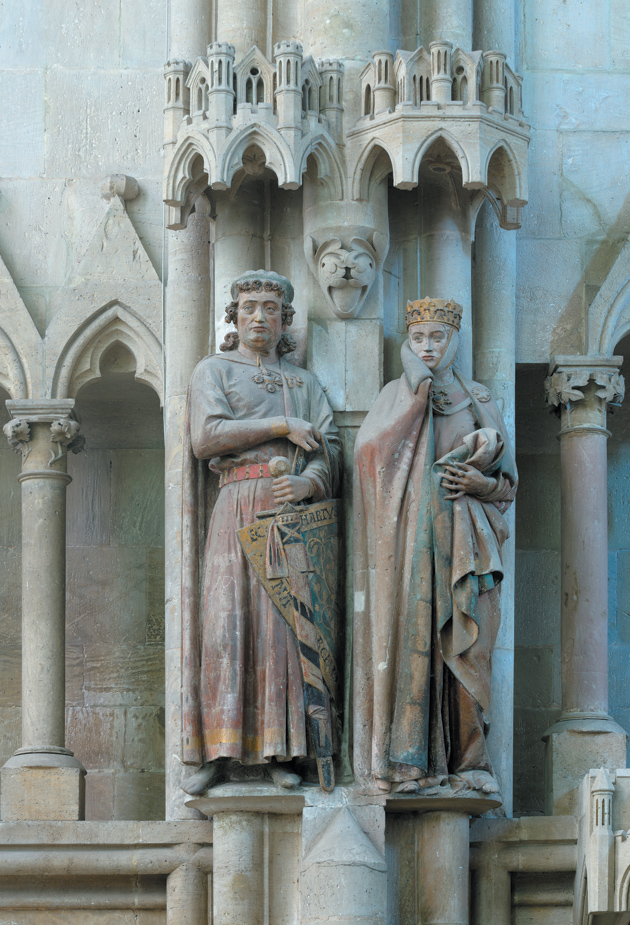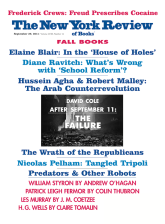In its first twenty-odd years, postwar Germany had no shortage of exhibitions of medieval art; most of them reflected the nostalgic yearnings of a politically and morally insecure country clinging to its Christian past. The 1950 show “Ars Sacra” in Munich invoked the transcendence of “Ottonian” art, named for the dynasty of Holy Roman Emperors founded by Otto the Great (912–973). In 1966 the “coronation town” of Aachen, where the German kings were crowned until 1531, staged a splendid show on Charlemagne which resonated with Germany’s push for increased cooperation within the European community. Shortly thereafter, the Cologne show “Rhein und Maas” (The Rhine and the Meuse) turned westward to focus on the art of the region between Liège and the Rhineland monasteries.
But in all those years, almost no attention was paid to the medieval art of the Duchy of Saxony, the German heartland, a large part of which was included in the German Democratic Republic (DDR). It wasn’t until after reunification in 1990 that a series of exhibits in Magdeburg in the former DDR reminded us of the migration—or invasion—of the Gothic style into Mitteldeutschland: Saxony, Saxony-Anhalt, and Thuringia. It was the rediscovery of a world that had sunk into obscurity.
In the episcopal town of Naumburg, the state of Saxony-Anhalt is now sponsoring a triumphant show with a trumpet blast of a title: “The Naumburg Master: Sculptor and Architect in the Europe of Cathedrals.” When it was first announced, some skepticism was called for. Hadn’t the very concept of a somewhat mysterious “Naumburg Master” been irredeemably contaminated by the chauvinistic dithyrambs of German nationalism? And besides, where would the organizers turn for the loan works they would need for a comprehensive exhibition of monumental sculpture in the High Middle Ages?
Yet until November 2, we can wander with delight through a resoundingly successful show. Both the exhibition and its catalog have rescued the works of the Naumburg Master from the jaws of jingoism and embedded them not only in their European setting, but above all in the setting of Christian devotional history. Gone are the rhapsodies to the “sacred shrine of Germanic sculpture.” Instead, we are reminded of the tradition of creating memorials to donors and representing Christ’s Passion with a new empathy as it can be observed in the age of Saint Francis. The exhibition brings about nothing less than a historical rehabilitation of the Naumburg sculptures.
The show’s curators have succeeded in attracting a wealth of spectacular loans, chief among them sculptures from Champagne and the crown lands of the Capetian kings, who ruled France between 987 and 1328. The sculptures are supplemented by crowns, weapons, manuscripts, documents, and seals, making the show a mirror of courtly culture in the kingdom of France and the German principalities. One of its chief pleasures is the unique way the sculptures and artifacts are distributed among Naumburg’s sacred spaces, starting with the cathedral and its precinct and St. Mary’s Church at one corner of the cloister. Even the Schlösschen, the “little palace” on the market square, provides appropriately venerable surroundings for the artifacts displayed there. While exhibitions of medieval art often have something of a jewelry-store atmosphere, in Naumburg one feels one is paying a romantic visit to a vanished world. It gives pause for thought that such a deep exploration is possible in a city in the largely de-Christianized former German Democratic Republic. It’s hard to imagine a comparable show being presented in the glitzy media circus of the West.
To recall the historical point of departure: in 1028, probably at the behest of the local lords, the bishopric of Zeitz was transferred to Naumburg. In the thirteenth century a new cathedral was built, beginning with the Romanesque East Choir dedicated to Saints Peter and Paul. A transformation set in with the construction of the West Choir dedicated to the Virgin Mary. A new master architect and his workshop were imported from Reims in France to construct it in the Gothic style. The famous sculptures of the Naumburg Master were created during this stylistic shift. A sculptured rood screen telling the Passion story in moving scenes separates the choir from the Romanesque nave. Beyond this screen, twelve life-size statues of aristocratic men and women line the wall of the West Choir. Unexpectedly naturalistic in clothing, expression, and gesture, they astound the viewer with their depiction of strong emotion, particularly aristocratic piety. These freestanding statues, apparently without equal anywhere, long encouraged art historians to speculate about their origins and significance. They were taken to depict the founding donors to the Naumburg cathedral.
Advertisement
As for influences, the reactions to the enigmatic work of the Naumburg Master congealed into the legend of an artist whose ardent drive for expression resulted from his ebullient German soul and whose apprenticeship and journeyman years took him to the great cathedrals of France. For none of these speculations was there any documentary evidence. The only certainty is that these statues memorialize the long-dead founders of the cathedral. Despite the popular names they have been given (especially the ubiquitously reproduced female figure called “Uta”), their actual names are not definitively documented.
A stated goal of the exhibition is to solve the art-historical riddle of the “Naumburg Master” through close scrutiny. Entering the cathedral, visitors encounter the main exhibits assembled next to the rood screen of the West Choir and illuminating its uniqueness by comparison. Rood screens—sculptured partitions, with a representation of the Crucifixion—were built to separate the congregation in the nave from the clergy saying the prayers in the chancel. None of the screens of French cathedrals remains standing, but fragments of narrative reliefs taken from the screens formerly in Amiens, Bourges, Chartres, and Paris have survived. In Naumburg, there are examples of all of these, one next to the other, and they demonstrate the skill with which Gothic sculptors depicted the gospel stories, with a theatricality exceeding even that of the sculptures at the main portals.
The high points among them are fragments of the rood screen from St. Martin’s Choir in the cathedral of Mainz. They tell the story of the Last Judgment, depicting damnation and bliss with vigorous expressiveness. Among the blessed, a mendicant friar reminds us of the Franciscan origins of such emotional piety. The screen that still survives in Naumburg goes a step further: it brings the sculpture of the crucified Christ down from its normal position above the elevated chancel and places him just above the center of the divided screen, so that for the eyes of the faithful, the Man of Sorrows hangs above the gates of redemption. Here we touch the spiritual roots of the emotional agitation evident in the statues of the choir. Death and redemption are at stake, along with supplication and salvation.
Yet as free of preconceptions as it is, the show does not entirely escape folkish sentimentality; an embarrassing cliché of art historians survives, namely, the elegant Frenchman versus the ponderous German. The curators were seduced into trying to illustrate this contrast by one of the most beautiful works on loan, the statue of King Childebert I, made at the same time as the donor statues in Naumburg, for the refectory of the monastery of Saint-Germain-des-Prés in Paris. It possesses the most refined delicacy and grace of movement and gesture—a courtly complement to the work of the Naumburgers. But a comparison ought not to insist on invoking differences in national character. Rather, it must take into account the differences in feudal society between west and east.
Capetian France was a kingdom, and its ecclesiastical sculpture repeatedly produced images of kings but not of the nobility. The task of the Naumburg sculptors, on the other hand, was to depict territorial princes who dressed and armed themselves in a different manner, one not subject to courtly protocol but more free and easy. One cannot separate the expressions of the Naumburg founders from these social conditions. The depiction of passion is always a form of social communication.
It was not the art of Paris but the sculptures of the Reims cathedral that inspired the workshop in Naumburg. In the statues, columns in human shape, and masks of Reims, all the influences—the sculpture of classical antiquity, the treasury art of Lorraine, and the elegance of Paris—flowed together and reinforced one another to produce physiognomic drama unequaled anywhere. The Naumburg curators have been able to bring together numerous works from Reims—both original and cast reproductions—in order to demonstrate that the Naumburg sculptors drew their inspiration from this source. They transformed mask-like heads from Reims into the animated faces of the donors to the Naumburg religious complex and discovered in the royal statues in Reims the inspiration for the ways that the cloaks of two of the donors, Uta and Wilhelm von Camburg, are folded.
No review can do justice to the wealth of references in this comprehensive show. The thirteenth century also marked an Aristotelian turn in the history of science. People began to study plants and animals more closely. The exhibition documents how local flora replaces the older, stylized foliage decorating the capitals of columns, and a magnificent stone tablet from the rood screen in Chartres shows a naturalistic lion, lamb, and steer. Right next to them is an astonishing hunting scene, a feast for the eyes.
A final critical question should not in any way diminish the joy and gratitude one feels for this exhibition, which brings the art of the High Middle Ages so vividly and unexpectedly to life. Doesn’t the title “The Naumburg Master: Sculptor and Architect in the Europe of Cathedrals,” however, still perpetuate the nationalistic “legend of the artist”? We can all agree that the sculptors working in Naumburg left Reims around 1235, when construction there was interrupted by local civil unrest, and were recruited for new work farther to the east. But none of the other towns through which the “Master” allegedly passed on his way to Naumburg—places where he is supposed to have worked and learned, including a newly conjectured stay at Coucy—are convincingly connected to the rood screen or the statues of the founders.
Advertisement
Even the assumption—which has long since acquired the status of fact—that the Naumburg Master himself worked on the rood screen in Mainz until 1239 is not a certainty. The surviving fragments from Mainz have a nervous sensibility unlike the figures in Naumburg. Could it not be that some of the workers migrating east from Reims remained in Mainz while others continued immediately on to Naumburg? This would in no way diminish the quality of their works, but the dissemination of their passionate and moving art would then appear in the historical record as a mighty river and the Germanic demiurge, the “Naumburg Master in the Europe of Cathedrals,” would turn out to be a legend concocted by art historians.
As early as 1944, the American art historian Charles Seymour commented on the attribution of early French sculpture to the Naumburg Master:
The movement [to create such sculpture] is so broad and the accomplishment so large, the postulate of individual and “national” responsibility appear inadequate. In this sense, the piling up of additions to the work of the “Naumburg Master” especially in France defeats their aim. They merely increase a myth-like aura about a development which deserves a place in history.*
I fear he was right.
—Translated from the German by David Dollenmayer
This Issue
September 29, 2011
School ‘Reform’: A Failing Grade
Coming Attractions
After September 11: The Failure
-
*
Gazette des Beaux Arts, sixth series, Vol. 26 (1944), pp. 181–182. ↩




